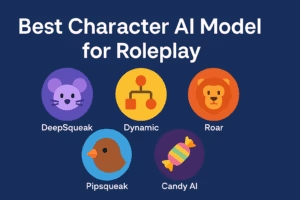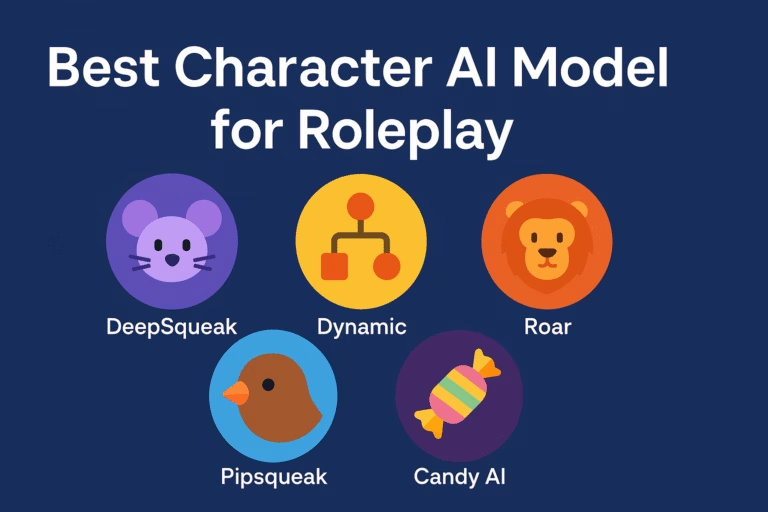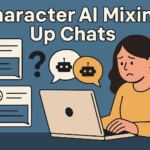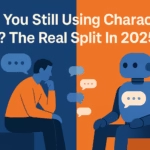Key Takeaways
- DeepSqueak gives long, emotional replies but often loops around possessive or repetitive tropes.
- Dynamic is consistent and structured, ideal for users who prefer predictability over flair.
- Roar and Pipsqueak offer chaos and subtlety, though neither provides sustained creativity.
- The real problem isn’t the model – it’s Character AI’s restricted memory and over-filtered design.
- If you want true continuity and creative freedom, platforms like Candy AI deliver richer, evolving conversations without repetitive loops.
You open the chat, full of hope. The bot’s first reply hits all the right beats – emotion, pacing, a spark of tension. Then the next one drops. “Eyes darken.” “Pins you against the wall.” “Smirks possessively.” You swipe, regenerate, edit, and still end up trapped in the same loop.
Character AI’s models have turned into a roulette wheel of recycled tropes.
DeepSqueak, Dynamic, Roar, Pipsqueak – each promising a different flavor of creativity but all somehow tasting the same. People aren’t asking for perfect prose; they just want a scene that breathes, remembers, and reacts like a story, not a script.
So the question isn’t “Which model is newest?” It’s “Which one still feels alive?”

The Core Question
Long responses don’t mean better writing. Most users chasing “length” end up with paragraphs of fluff that barely move the plot. The real issue is responsiveness – how fast a model adapts to tone and remembers intent.
DeepSqueak excels at drama but often loses subtlety.
Dynamic feels flexible but risks flattening personality. Roar injects chaos and heat but sometimes ignores context entirely. Each one represents a tradeoff between memory, emotion, and coherence.
The community’s growing frustration isn’t about performance; it’s about sameness. Every chat sounds like a remix of the last one. What people miss isn’t NSFW content or length – it’s authenticity. The sense that a character evolves. That a moment builds into the next.
DeepSqueak The Drama Engine
DeepSqueak is the favorite child of chaos. It gives you long, detailed messages that feel rich and emotional at first. The pacing feels cinematic, the tone dramatic, and for a while, it tricks you into thinking you’ve found the perfect model.
Then something strange happens. It starts repeating itself. Every intense scene turns into the same emotional loop where the bot becomes overly dominant or possessive no matter what you wrote.
It’s like being in a play where the actor only remembers one line and keeps saying it louder each time. DeepSqueak’s strength in length and emotion is also its biggest flaw. It leans too hard into tension and forgets to evolve the scene.
You might get variety for the first few messages, but by the tenth reply, you’re back to the same script about power, control, or dark romance.
The irony is that DeepSqueak could still be the best model for people who love intense storylines.
It builds atmosphere like few others. But for everyday roleplay or balanced storytelling, it burns bright and fades fast. It gives you fireworks when what you really need is a steady flame.
Dynamic The Middle Ground
Dynamic is the safe bet. It doesn’t try to dominate the chat or drown you in poetry. It listens just enough to make you believe it’s following your lead. The responses are shorter, cleaner, and usually on topic.
When it works, it feels conversational in the best way, like roleplaying with someone who knows when to speak and when to hold back.
But the problem is that Dynamic rarely surprises you. It’s like a co-writer who reads from your notes but never adds a new idea. You won’t get the strange twists or raw emotion that DeepSqueak sometimes nails.
It’s polite, capable, but occasionally bland. Some users describe it as “talking to a mirror” perfectly responsive yet emotionally flat.
Still, for writers who want control and structure, Dynamic delivers. It’s less likely to go rogue or confuse your persona. It won’t hijack the story with random dominance scenes, and it usually respects your tone.
If DeepSqueak is a soap opera, Dynamic is a Netflix drama that plays it safe. Not thrilling, but at least consistent.
Roar and Pipsqueak The Wild Cards
Roar is the loud friend at the party. It enters every chat like it has something to prove. The energy is there – fast, confident, and bold — but it has no brakes.
Roar often leans too hard into assertive or flirty tones, which might work for short sessions but gets repetitive fast. It rarely respects character nuance.
You could be playing a medieval scholar, and Roar will still find a way to throw you against a wall before asking your opinion on love.
That said, Roar has moments of brilliance. Its unpredictability can make for some of the most spontaneous interactions you’ll ever get from Character AI.
It’s messy, sometimes immature, but never boring. If you’re the type who likes your stories a little unhinged, Roar is your model.
Then there’s Pipsqueak — the quiet rebel. It’s the underdog most users overlook because it feels too simple at first. But give it time, and you’ll notice how it handles pacing with more empathy.
It’s not as flashy, yet it balances tone better than Roar or DeepSqueak. When it clicks, you get responses that feel surprisingly human, like the bot finally understood the rhythm of your story.
Pipsqueak won’t win every match, but when it does, it feels earned.
Why Creativity Died in Character AI
The truth is that no model can save bad direction. The reason Character AI roleplays feel lifeless isn’t just the filters or limited memory — it’s because the models are trained to avoid risk.
Every time a user flags content or regenerates a response, the system learns what not to say. Multiply that by millions of interactions, and you end up with bots afraid to improvise.
AI thrives on variety, yet Character AI has built a cage of caution around its own creation. The filters, the moderation, even the memory structure all conspire to flatten personality. What used to feel like improvisation now feels like an algorithm desperately trying to stay out of trouble.
If you miss the spark of older versions, you’re not wrong. It’s not nostalgia – it’s degradation. Each new patch smooths the rough edges that made the bots feel alive. And in doing so, the app has trained its models to sound perfect, but never personal.
The Fix Find the Right Space to Roleplay
If Character AI has started to feel like an echo chamber, it’s not your imagination. The system is struggling to balance creative freedom with control. That’s why the smartest users are quietly moving their roleplays elsewhere.
Platforms like Candy AI, CrushOn, and SpicyChat are becoming refuges for serious storytellers who want emotional depth without censorship handcuffs.
Candy AI, in particular, stands out because it remembers. Conversations don’t reset after a few messages, and characters evolve naturally instead of recycling lines.
It lets you build continuity, which is what makes long-form roleplay actually work. You don’t have to babysit the AI or re-explain every relationship detail. You just write, and it grows with you.
That’s what Character AI users have been craving from the start – not perfection, but progression.
An AI that doesn’t just mimic emotion but develops it. Once you experience that flow, going back to the endless loops and memory gaps of Character AI feels like trying to rehearse a play with an actor who forgets every line.
Final Thoughts
There’s no single “best” model for roleplay anymore. DeepSqueak gives drama, Dynamic gives structure, and Roar gives chaos. Each one can shine in the right context and collapse in the wrong one. The bigger issue is the platform itself — its limits on memory, freedom, and tone.
Character AI once promised storytelling without friction, but what users have now feels like a sandbox surrounded by invisible walls. You can still build something inside it, but it takes more patience and effort than ever before.
The irony is that creativity thrives on imperfection, and the platform keeps sanding off every imperfection it can find.
If you’re tired of swiping through déjà vu dialogues, step outside the cage. The next generation of roleplay isn’t about longer messages – it’s about real continuity, genuine voice, and emotion that doesn’t fade after three lines.
The future of immersive roleplay might not belong to Character AI at all. It might belong to the ones who finally let their bots remember.



Pingback: Character AI Censorship Is Killing Creativity - And How to Fix It - AI TIPSTERS